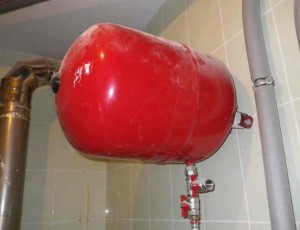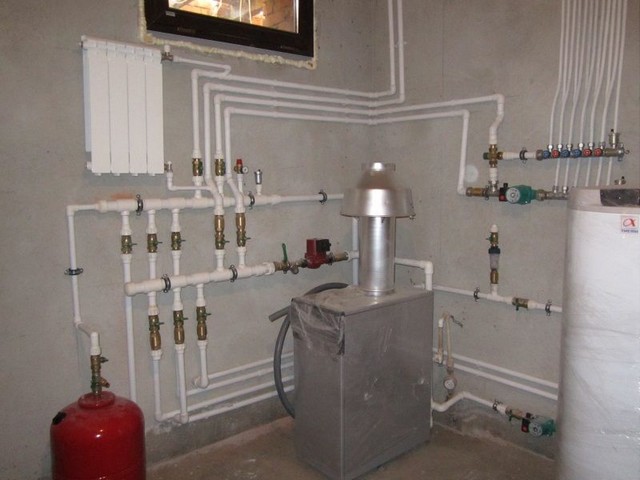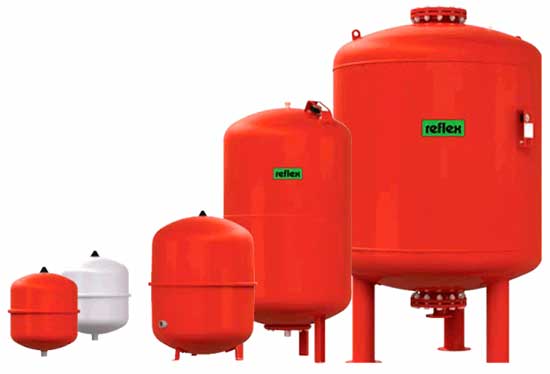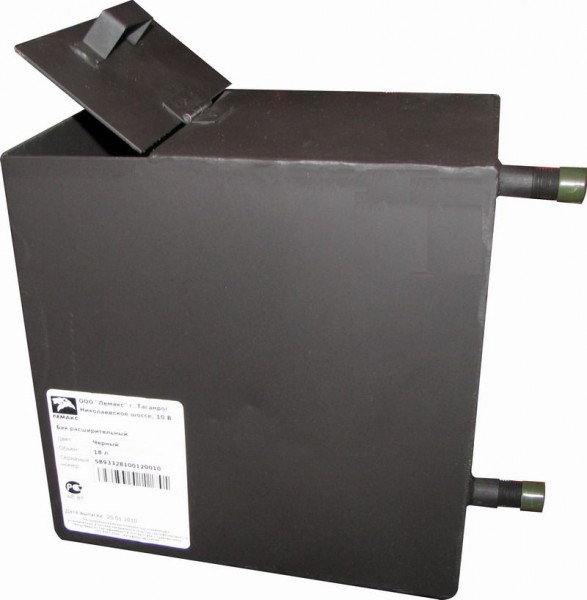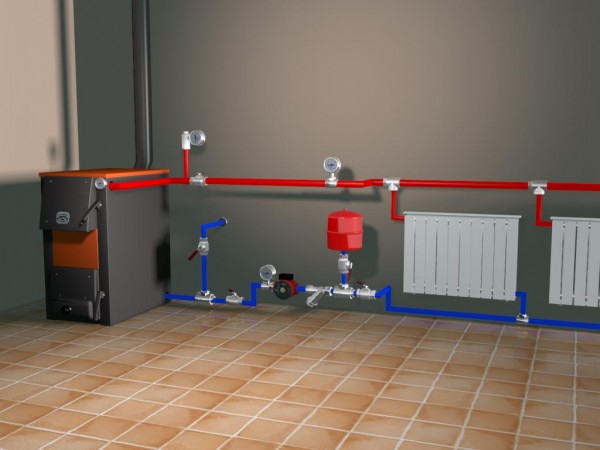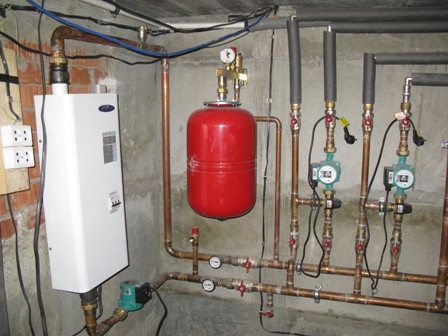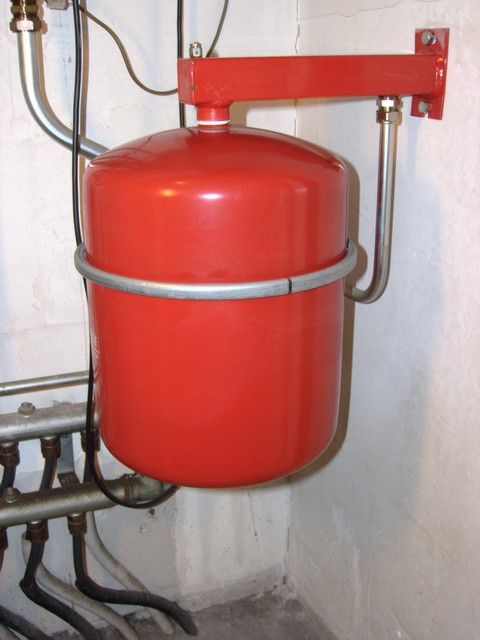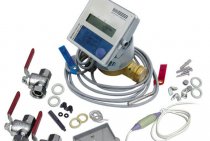Installation of an expansion tank in an open and closed heating system
In modern heating systems, to compensate for the thermal expansion of the coolant, expansion tanks of an open or closed type are installed, which have special requirements for installation, operating conditions and have various advantages and disadvantages.
In this article, we will consider the main points of choosing and installing an expansion tank in a heating system with forced and natural circulation of the coolant.
The main parameter of the tank is its useful volume, which must exceed the amount of change in the volume of the liquid in the system as a result of the maximum change in its temperature.
The volume of liquid in the heating system is not constant, since the coolant can expand and contract during operation. Heating of the coolant, and, accordingly, an increase in its volume at a constant size of the internal space of the heating system leads to an increase in pressure on the walls of pipelines and heating equipment, which can cause their destruction.
To compensate for changes in the volume of liquid and stabilize the pressure on the inner walls of the components of the heating system, an expansion tank is introduced into its circuit (also known as an expansion tank, from the English verb "expanse", which means "expand"). When the coolant expands, its amount, which exceeds the volume of the internal space of the system, enters the expander, and after the temperature drops, it returns back.
Features of mounting a membrane expansion tank
- What is the function of a membrane tank
- Scope of the membrane tank
- Types of expansion tanks
- Benefits of closed tanks
- Types of closed tanks
- Installation of a closed-type expansion tank
- Features of installing a membrane-type expansion tank
Everyone wants to see their home beautiful and comfortable.
At the same time, it is very important that all desires and dreams are supported by the financial possibility of turning your dreams into reality. In addition, modern technology will not matter.
Thanks to them, today the arrangement of any system in the house has become possible in the shortest possible time. This also applies to the membrane expansion tank, which is the key to the heating system at home.
It is the installation of this element of the heating system that should be given special attention.

Membrane expansion tank device.
Expansion tank functions
What is the purpose of the expansion tank? The heating system is filled with a fixed amount of fluid (water or antifreeze) that is prone to thermal expansion. This means that an increase in the temperature of the coolant inevitably leads to an increase in pressure in the system. Since pipes, radiators and other elements of an engineering structure are inelastic, increased pressure will lead to depressurization of the system - a breakthrough will occur at the weakest point.
Water is characterized by low compressibility, so a special device is built into the system - a membrane or open tank. Its function is that when the pressure rises, air will be compressed. This makes it possible to provide protection against water hammer. The installed expansion tank protects the system from excessive pressure increase.
Membrane tanks are designed for a closed-type heating system - they are a container with an elastic waterproof membrane inside, which divides the internal volume into two parts. The membrane is needed so that air does not come into contact with the coolant.Otherwise, airing the network and increasing the risk of corrosion of the steel elements of the system cannot be avoided.
In an open type system, the tank communicates with the atmosphere, due to which air is bled from the pipes. For this reason, the installation location of an open tank is strictly regulated - it must be located at the highest point in the system.
Models of the Zilmet OEM-Pro series
This expansion tank for the heating system reviews, as a rule, receives a positive character. Many buyers praise it for its durable case. Also, the device uses a good fuse. The membrane at the tank is used only one. If you trust the experts, then it is erased slowly. It is recommended to install the model behind the radiator grille.
It is also worth noting that the modification is not afraid of high temperatures. A maximum of 10 liters of coolant is allowed. The air chamber is used in a small volume. The outlet valve in the device is designed for heavy loads. The limiting pressure indicator is not less than 2 Pa. The thermostat is recommended to be connected behind the rack above the mixer. For gas boilers, the modification is great. The price for it fluctuates around 1700 rubles.
How and where is the expansion tank placed
So, we are going to design and assemble a heating system with our own hands. If she also earns - our joy will not be the limit. Are there any instructions for installing the expansion tank?
open system
In this case, simple common sense will prompt the answer.
An open heating system is, in essence, one large vessel of complex shape with specific convection currents in it.
The installation of the boiler and heating appliances in it, as well as the installation of pipelines, must ensure two things:
- Rapid rise of the water heated by the boiler to the upper point of the heating system and its discharge through the heating devices by gravity;
- The unimpeded movement of air bubbles to wherever they rush in any vessel with any liquid. Up.
- The installation of a heating expansion tank in an open system is always carried out at its highest point. Most often - at the top of the accelerating manifold of a single-pipe system. In the case of top filling houses (although you hardly have to design them), at the top filling point in the attic.
- The tank itself for an open system does not need shutoff valves, a rubber membrane, and even a lid (except to protect it from debris). This is a simple water tank open on top, into which you can always add a bucket of water to replace the evaporated one. The price of such a product is equal to the cost of several welding electrodes and a square meter of steel sheet 3-4 mm thick.
It looks like an expansion tank for an open heating system. If desired, a water tap from the water supply can be brought into the hatch in it. But much more often, as the water evaporates, it is topped up with an ordinary bucket.
closed system
Here, both the choice of the tank and its installation will have to be taken quite seriously.
Let's collect and systematize the basic information available on thematic resources.
The installation of the expansion tank of the heating system is optimal in the place where the water flow is closest to laminar, where there is a minimum of turbulence in the heating system. The most obvious solution is to place it in a straight dispensing area in front of the circulation pump. At the same time, the height relative to the floor or the boiler does not matter: the purpose of the tank is to compensate for thermal expansion and dampen water hammer, and we perfectly bleed air through air valves.
Typical tank setup. Its location in a single-pipe system will be the same - in front of the pump along the water course.
- Tanks in the factory are sometimes supplied with a safety valve that relieves excess pressure. However, it is better to play it safe and make sure that your product has it.If not, buy and mount next to the tank.
- Electric and gas boilers with electronic thermostats are often supplied with a built-in circulation pump and a heating expansion tank. Before you go shopping, make sure you need them.
- The fundamental difference between membrane expansion tanks and those used in open systems is their orientation in space. Ideally, the coolant should enter the tank from above. This subtlety of installation is designed to completely remove air from the compartment of the tank that is intended for liquid.
- The minimum volume of the expansion tank for a water heating system is taken approximately equal to 1/10 of the volume of the coolant in the system. More is acceptable. Less is dangerous. The volume of water in the heating system can be roughly calculated based on the heat output of the boiler: as a rule, 15 liters of coolant per kilowatt are taken.
- A pressure gauge mounted next to the expansion tank and the make-up valve (connecting the heating to the water supply) can provide you with an invaluable service. The situation with a stuck spool of the safety valve, alas, is not so rare.
- If the valve relieves pressure too often, this is a clear sign that you miscalculated with the volume of the expansion tank. It is not necessary to change it at all. It is enough to purchase another one and connect it in parallel.
- Water has a relatively low coefficient of thermal expansion. If you switch from it to a non-freezing coolant (for example, ethylene glycol), you will again need to increase the volume of the expansion tank or install an additional one.
The expansion tank in the photo is mounted in accordance with all the rules: the coolant is connected from above, the tank is equipped with a pressure gauge and a safety valve.
Useful tips from professionals
Finally, we suggest that you familiarize yourself with practical tips that may prevent the occurrence of certain errors in the workflow:
As you might have guessed, the actual volume of the expansion tank is calculated according to a complex formula, and if you are not an expert, then you should not be too zealous and delve into the numbers - take as a basis the standard figure of 10% of the total coolant volume.
If, during the operation of a self-made expansion tank in the heating system, the safety valve is triggered too often, this indicates that the volume of the tank was calculated incorrectly. And this, in turn, means that you made a mistake with the calculation of the total volume of coolant in the system
The solution in this situation is very simple: add another expansion tank to the system, which compensates for the missing volume.
In order for the piping to be installed correctly, special attention should be paid to only two places in the system: the place where the coolant enters the expansion tank (should be at the top point) and the place where it leaves (carried out from below).
To avoid boiling liquid in the expansion tank, take care of two things: a well-chosen diameter of the contour pipes and the slope of the circuits.
We introduced you to general information about expansion tanks in the heating system, and also provided instructions for making an effective design with your own hands. We wish you good luck!
Types of expansion tanks
The location of the tank is determined by the type of heating system itself. She may be:
It looks like a closed expansion tank in an already installed heating system.
Important! An open-type heating system is used very rarely today. In everyday life, they are used only in old buildings.
The expansion tank in open heating systems is made in the form of a container, the top of which does not close. Its connection to the heating system is carried out using a threaded connection located at the bottom of the tank.
The installation and operation of a closed-type expansion tank in a heating system also has its own characteristics. The design of the closed type tank is made in the form of a hermetically sealed capsule, which is divided into two parts using a rubber membrane.
Features of installing a membrane-type expansion tank
Installing and connecting an expansion tank to a heating system is fraught with some difficulties. Moreover, making mistakes at work, you can face a huge number of problems. Therefore, at the slightest doubt in your abilities, you should not take up the job yourself.
Installation of an expansion membrane unit involves the use of the following tools and materials:
- gas key;
- wrench;
- stepped key;
- plastic pipes.
Indicators of instruments during operation of the expansion tank.
When installing heating a country house using an expansion tank, the tightness of the connections is very important. In this case, in no case should low-quality seals be used, which, as a rule, cannot withstand high temperatures.
The installation of a membrane-type tank must be carried out in accordance with the general rules and regulations to ensure the safe operation of the heating system.
The body of the membrane tank is divided into two parts by means of a flexible membrane. In one of them water accumulates, and in the second air or gas, which is compressed to a predetermined pressure. From the heating systems, the coolant passes into one part, and the second part, which is under high pressure, at this time is filled with air supported by the nipple.
Such installation requires correct calculations to determine the exact technical parameters. The tank must be connected to a pipeline that runs in the immediate vicinity of the boiler. At the same time, a safety device is installed on the pipeline without fail, which prevents excess pressure.
The membrane tank must not be dismantled and dismantled during operation. In addition, it cannot be opened and drilled with force.
In order to prevent corrosion and increase the life of the heating system and pipes, water must circulate without oxygen impurities and other aggressive gases.
Manufacturers and prices
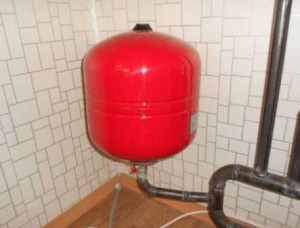
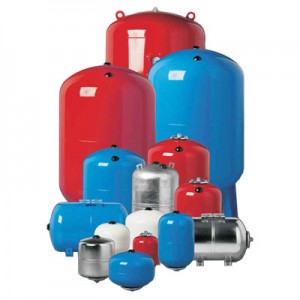
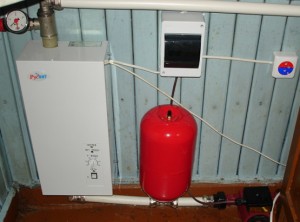
It should be borne in mind that it is important not only to buy an expansion tank for closed-type heating, it also requires its correct installation. Having the necessary skills, subject to the instructions, it is possible to install it yourself
If the master still has any doubts about his knowledge, then it is best to turn to professionals to ensure the stable operation of the heating network and eliminate possible malfunctions.
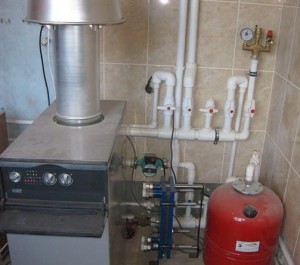
Calculation of the physical dimensions of the device
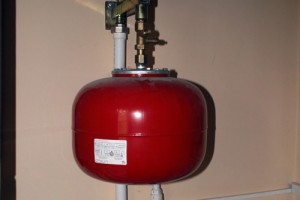
To find out which expansion tank for heating should be installed in the system, the owner needs to have information regarding the following parameters:
- the total volume of water in the circuit;
- nominal pressure;
- circuit temperature range.
Next, you should calculate the volume that water creates when heated. This can be done based on the following information - when heated from 20 to 80 degrees, the coolant expands by 5%. In addition to this five percent, another five percent is added for the stock.
The installation of an expansion tank in the heating system must compensate for an expansion equivalent to the volume of a tenth of the water in the circuit.
Knowing how much expansion tank is needed for heating, the owner can easily determine its physical dimensions.
Installation of the membrane device
A hydraulic accumulator of this type is installed where there is a minimum probability of coolant turbulence, since a pump is used for the normal circulation of the water flow along the circuit.
Correct container position
When connecting an expansion tank to a closed heating system, it is imperative to take into account the location of the air chamber of the device.
The rubber membrane periodically stretches and then contracts. Due to this impact, microcracks appear on it over time, which gradually increase. After that, the membrane has to be replaced with a new one.
If the air chamber of such a tank remains at the bottom during installation, then the pressure on the membrane will increase due to gravitational influence. Cracks will appear faster, repairs will be needed sooner.
It makes more sense to install the expansion tank so that the compartment filled with air remains on top. This will extend the life of the device.
Features of choosing an installation site
There are a number of requirements to consider when installing a membrane expansion tank:
- It cannot be placed close to the wall.
- Ensure free access to the device for its regular maintenance and necessary repairs.
- The tank hung on the wall should not be too high.
- A stopcock should be placed between the tank and the heating pipes, which will allow the device to be removed without completely draining the coolant from the system.
- The pipes connected to the expansion tank, when wall-mounted, must also be attached to the wall in order to remove possible additional load from the tank nozzle.
For a membrane device, the return section of the line between the circulation pump and the boiler is considered the most suitable connection point. Theoretically, you can put an expansion tank on the supply pipe, but the high temperature of the water will adversely affect the integrity of the membrane and its service life.
When using solid fuel equipment, such placement is also dangerous because steam can enter the container due to overheating. This will seriously disrupt the operation of the membrane and may even damage it.
In addition to the stopcock and the “American”, it is recommended to install an additional tee and a tap when connecting, which will allow you to empty the expansion tank before turning it off.
Setting up the instrument before use
Before installation or immediately after it, it is necessary to correctly adjust the expansion tank, otherwise called the expansion tank. This is not difficult to do, but first you need to find out what pressure should be in the heating system. Let's say an acceptable indicator is 1.5 bar.
Now you need to measure the pressure inside the air part of the membrane tank. It should be less than about 0.2-0.3 bar. Measurements are carried out with a manometer with a suitable graduation through a nipple connection, which is located on the tank body. If necessary, air is pumped into the compartment or its excess is bled off.
The technical documentation usually indicates the working pressure, which is set by the manufacturer at the factory. But practice shows that this is not always true. During storage and transportation, part of the air could escape from the compartment. Be sure to take your own measurements.
If the pressure in the tank is set incorrectly, this can lead to air leakage through the device for removing it. This phenomenon causes a gradual cooling of the coolant in the tank. It is not necessary to pre-fill the membrane tank with coolant, just fill the system.
Tank as additional capacity
Modern models of heating boilers are often already equipped with a built-in expansion tank. However, its characteristics do not always correspond to the requirements of a particular heating system. If the built-in tank is too small, an additional tank must be installed.
It will ensure the normal pressure of the coolant in the system. Such an addition will also be relevant in case of a change in the configuration of the heating circuit. For example, when a gravity system is converted into a circulation pump and old pipes are left.
This is true for any systems with a significant amount of coolant, for example, in a two-three-story cottage or where, in addition to radiators, there is a warm floor. If a boiler with a built-in small membrane tank is used, the installation of another tank is almost inevitable.
An expansion tank will also be appropriate when using an indirect heating boiler. A relief valve, similar to that installed on electric boilers, will not be effective here, an expansion valve is an adequate way out.
Types of heating systems
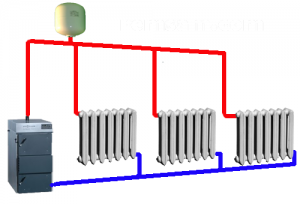
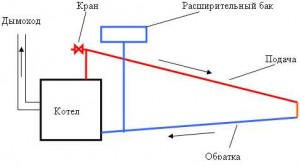
With a more modern closed circuit, an expansion tank of a closed-type heating system with a built-in internal membrane is used.
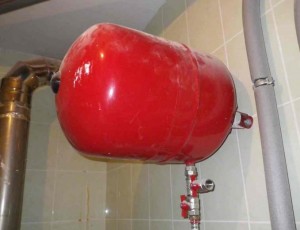
Expander operation
Maintaining a membrane-type expansion tank in working condition includes:
- regular visual inspection for corrosion;
- checking the integrity of the membrane;
- air (gas) pressure check.
Maintenance of open type tanks provides for an external inspection of the condition of the body and thermal insulation, as well as checking the liquid level, which should not fall below the minimum mark.
Expansion tank on the bracket.
The correct choice and installation of an expansion tank in the heating system is one of the components of a reliable, uninterrupted and safe operation of the entire heating system of a residential building. Today, a closed-type expansion tank with a diaphragm-diaphragm is more often installed, combining an affordable price and a high level of ease of use.
Interior solution: decorative grilles for heating radiators
Optimal thermal insulation for heating pipes
Independent insulation of heating pipes on the street
Purpose of the device
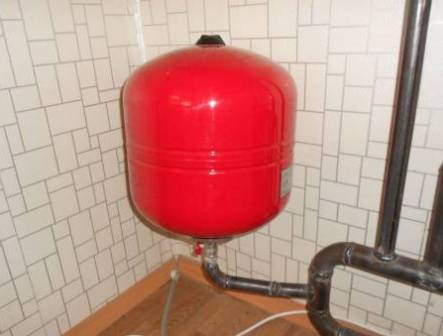
The physical properties of the liquid - to increase in volume when heated and the impossibility of compression at low pressures - suggest the mandatory installation of expansion tanks in heating systems.
When heated from 10 to 100 degrees, water increases in volume by 4%, and glycol liquids (antifreeze) by 7%.
Heating built using a boiler, pipelines and radiators has a finite internal volume. The water heated in the boiler, increasing in volume, does not find a place to exit. The pressure in the pipes, radiator, heat exchanger rises to critical values that can break the structural elements, squeeze out the gaskets.
Private heating systems withstand, depending on the type of pipes and radiators, up to 5 atm. Safety valves in safety groups or in boiler protection equipment operate at 3 Atm. This pressure occurs when water is heated in a closed container to 110 degrees. The working limits are considered to be 1.5 - 2 Atm.
To accumulate excess coolant, expansion tanks are installed.
After cooling, the volume of the coolant returns to its previous values. To prevent the radiators from airing, water is returned to the system.
Types of heating systems
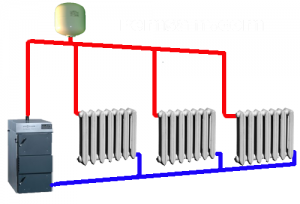
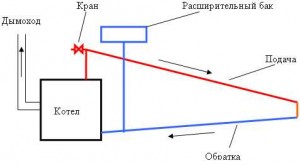
With a more modern closed circuit, an expansion tank of a closed-type heating system with a built-in internal membrane is used.
